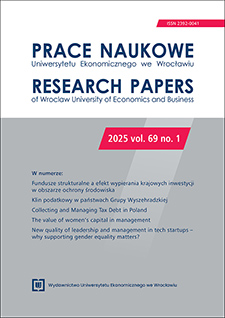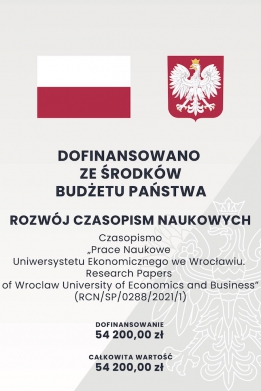Wirtualność i zaufanie: wpływ poziomu wirtualności zespołu na zaufanie lidera do jego członków
DOI:
https://doi.org/10.15611/pn.2025.1.07Słowa kluczowe:
przywództwo, globalne zespoły wirtualne, zaufanieAbstrakt
Cel: Celem badania jest identyfikacja i analiza zależności pomiędzy poziomem wirtualności zespołu
a poziomem zaufania, którym lider obdarza jego członków.
Metodyka: Badanie zostało zrealizowane za pomocą metody CAWI, a grupa badawcza obejmowała liderów międzynarodowych korporacji mających swoje indywidulane profile na portalu LinkedIn. Respondenci zostali poproszeni o wypełnienie elektronicznego formularza zawierającego kwestionariusze ankiet. Wszystkie pytania były w języku angielskim.
Wyniki: Wyniki badania wykazały, iż niektóre aspekty współpracy wirtualnej, takie jak praca w różnych strefach czasowych, wykazują pozytywne związki z pewnymi czynnikami zaufania, inne zaś, jak brak interakcji twarzą w twarz czy różne metody monitorowania pracy, stanowią wyzwania dla budowania zaufania.
Oryginalność/wartość: Artykuł wnosi wkład do badań nad zaufaniem w zespołach wirtualnych, przedstawiając analizę zaufania z perspektywy lidera i jego zaufania do zespołu oraz zależności między różnymi wymiarami wirtualności i wymiarami zaufania.
Pobrania
Bibliografia
Alward, E. i Phelps, Y. (2019). Impactful Leadership Traits of Virtual Leaders in Higher Education. Online Learning, 23(3), 72-93.
Arling, P. A. i Subramani, M. (2011). The Effect of Virtuality on Individual Network Centrality and Performance in On-Going, Distributed Teams. International Journal of Internet and Enterprise Management, 7(4), 325. https://doi.org/10.1504/IJIEM.2011.045111
Benda, A. N., Kramer, W. S., Baak, M. E., & Feitosa, J. (2023). Understanding Trust in Virtual Work Teams. In L. L. Gilson, T. O’Neill & M. T. Maynard (Eds.), Handbook of Virtual Work (pp. 305-324). Edward Elgar Publishing.
Bierly, P. E., Stark, E. M., i Kessler, E. H. (2009). The Moderating Effects of Virtuality on the Antecedents and Outcome of NPD Team Trust. Journal of Product Innovation Management, 26(5), 551-565. https://doi.org/10.1111/j.1540-5885.2009.00680.x
Breuer, C., Hüffmeier, J., Hibben, F., i Hertel, G. (2020). Trust in Teams: A Taxonomy of Perceived Trustworthiness Factors and Risk-taking Behaviors in Face-to-Face and Virtual Teams. Human Relations, 73(1), 3-34.
Campagna, R. L., Dirks, K. T., Knight, A. P., Crossley, C., i Robinson, S. L. (2020). On the Relation between Felt Trust and Actual Trust: Examining Pathways to and Implications of Leader Trust Meta-Accuracy. Journal of Applied Psychology, 105(9), 994.
Chamakiotis, P., Panteli, N., & Davison, R. M. (2021). Reimagining E-leadership for Reconfigured Virtual Teams due to Covid-19. International Journal of Information Management, 60, 102381.
Chudoba, K. M., Wynn, E., Lu, M., i Watson-Manheim, M. B. (2005). How Virtual Are We? Measuring Virtuality and Under-standing Its Impact in a Global Organization. Information Systems Journal, 15(4), 279-306.
Crisp, C. B. i Jarvenpaa, S. L. (2013). Swift Trust in Global Virtual Teams: Trusting Beliefs and Normative Actions. Journal of Personnel Psychology, 12(1), 45-56. https://doi.org/10.1027/1866-5888/a000075
Dirks, K. T. i de Jong, B. (2022). Trust within the Workplace: A Review of Two Waves of Research and a Glimpse of the Third. Annual Review of Organizational Psychology and Organizational Behavior, 9, 247-276.
Flavian, C., Guinalíu, M., i Jordan, P. (2019). Antecedents and Consequences of Trust on a Virtual Team Leader. European Journal of Management and Business Economics, 28(1), 2-24.
Ford, R. C., Piccolo, R. F., & Ford, L. R. (2017). Strategies for Building Effective Virtual Teams: Trust Is Key. Business Horizons, 60(1), 25-34.
Foster, M. K., Abbey, A., Callow, M. A., Zu, X., i Wilbon, A. D. (2015). Rethinking Virtuality and Its Impact on Teams. Small Group Research, 46(3), 267-299. https://doi.org/10.1177/1046496415573795
Gelston, G. M., Wells, C., i Dalton, A. (2018). Virtual Leadership in Complex Multiorganizational Research and Development Programs. 2018 IEEE Conference on Cognitive and Computational Aspects of Situation Management (CogSIMA), 97-102. https://doi.org/10.1109/COGSIMA.2018.8423974
Hacker, J. V., Johnson, M., Saunders, C., & Thayer, A. L. (2019). Trust in Virtual Teams: A Multidisciplinary Review and Integration. Australasian Journal of Information Systems, 23, 1-36.
Handke, L., Costa, P., & Feitosa, J. (2024). How Virtual Are We? Introducing the Team Perceived Virtuality Scale. Journal of Business and Psychology, 40, 455-478. https://doi.org/10.1007/s10869-024-09966-3
Jagoda, A. (2010). Problemy zarządzania zespołem wirtualnym w przedsiębiorstwie globalnym. Studia i Prace Kolegium Zarzą-dzania, 88.
Kirkman, B. L. i Mathieu, J. E. (2005). The Dimensions and Antecedents of Team Virtuality. Journal of Management, 31(5), 700-718.
Koźmiński, A. K. (2013). Ograniczone przywództwo. Studium empiryczne. Poltext.
Krawczyk-Bryłka, B. (2013). Zaufanie w zespole projektowym a (kobiecy) model przywództwa. Przedsiębiorczość i Zarządzanie, 14, 117-130.
Krawczyk-Bryłka, B. (2016). Budowanie zespołu wirtualnego: Zasady i wyzwania. Studia Informatica Pomerania, 2(40), 99-111.
Liao, C. (2017). Leadership in Virtual Teams: A Multilevel Perspective. Human Resource Management Review, 27(4), 648-659.
Lukić, J. M., i Vračar, M. M. (2018). Building and Nurturing Trust among Members in Virtual Project Teams. Strategic Mana-gement-International Journal of Strategic Management and Decision Support Systems in Strategic Management, 23(3).
Morganson, V. J., Major, D. A., Oborn, K. L., Verive, J. M., & Heelan, M. P. (2010). Comparing Telework Locations and Traditional Work Arrangements: Differences in Work-Life Balance Support, Job Satisfaction, and Inclusion. Journal of Managerial Psychology, 25(6), 578-595.
Orhan, M. A. (2017). The Evolution of the Virtuality Phenomenon in Organizations: A Critical Literature Review. Entre-preneurial Business and Economics Review, 5(4), 171-188. https://doi.org/10.15678/EBER.2017.050408
Prystupa-Rządca, K. i Latusek-Jurczak, D. (2016). Role of the Virtual Team Leader: Managing Changing Membership in a Team. The Laws of the Knowledge Workplace (s. 93-110). https://doi.org/10.4324/9781315556215-13
Robert, L. P., Denis, A. R., & Hung, Y. T. C. (2009). Individual Swift Trust and Knowledge-Based Trust in Face-to-Face and Virtual Team Members. Journal of Management Information Systems, 26(2), 241-279.
Robert, L. P. i You, S. (2018). Disaggregating the Impacts of Virtuality on Team Identification. Proceedings of the 2018 ACM Conference on Supporting Groupwork (s. 309-321). https://doi.org/10.1145/3148330.3148337
Schmidt, G. B. (2014). Virtual Leadership: An Important Leadership Context. Industrial and Organizational Psychology, 7(2), 182-187. https://doi.org/10.1111/iops.12129
Schwabe, M. (2023). Zaufanie jako niezbędny element funkcjonowania organizacji. Studia i Prace Kolegium Zarządzania i Finan-sów, 189, 113-131. https://doi.org/10.33119/SIP.2023.189.7
Schweitzer, L. i Duxbury, L. (2010). Conceptualizing and Measuring the Virtuality of Teams. Information Systems Journal, 20(3), 267-295.
Sieben, B. (2007). Themed Article: Doing Research on Emotion and Virtual Work: A Compass to Assist Orientation. Human Relations, 60(4), 561-580.
Spiewak, S., Strojny, P. i Strojny, A. (2011). Wirtualne zaufanie: Wpływ komunikacji zapośredniczonej przez komputer na podejmowanie decyzji o współpracy w sytuacji dylematu społecznego. Czasopismo Psychologiczne, 17, 75-83.
Spreitzer, G. M. i Mishra, A. K. (1999). Giving Up Control without Losing Control: Trust and Its Substitutes’ Effects on Managers’ Involving Employees in Decision Making. Group i Organization Management, 24(2), 155-187.
Zand, D. E. (1972). Trust and Managerial Problem Solving. Administrative Science Quarterly, 17(229).
Pobrania
Opublikowane
Licencja
Prawa autorskie (c) 2025 Jakub Wojnar

Utwór dostępny jest na licencji Creative Commons Uznanie autorstwa – Na tych samych warunkach 4.0 Miedzynarodowe.
Accepted 2025-04-02
Published 2025-05-28









